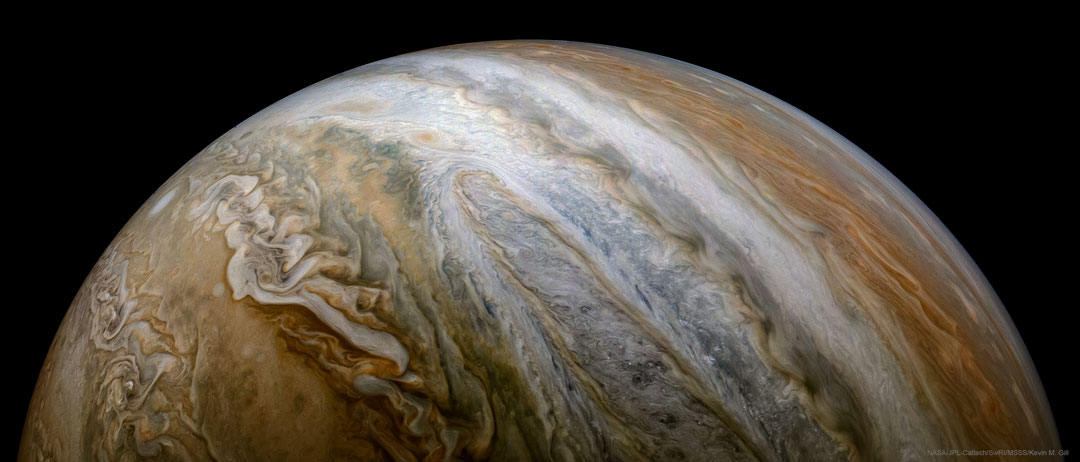2020年11月23日
A Jupiter Vista from Juno
Image Credit: NASA/JPL-Caltech/SwRI/MSSS; Processing & License: Kevin M. Gill;
Explanation: Why do colorful cloud bands encircle Jupiter? Jupiter’s top atmospheric layer is divided into light zones and dark belts that go all the way around the giant planet. It is high horizontal winds — in excess of 300 kilometers per hour — that cause the zones to spread out planet-wide. What causes these strong winds remains a topic of research. Replenished by upwelling gas, zonal bands are thought to include relatively opaque clouds of ammonia and water that block light from lower and darker atmospheric levels. One light-colored zone is shown in great detail in the featured vista taken by the robotic Juno spacecraft in 2017. Jupiter’s atmosphere is mostly clear and colorless hydrogen and helium, gases that are not thought to contribute to the gold and brown colors. What compounds create these colors is another active topic of research — but is hypothesized to involve small amounts of sunlight-altered sulfur and carbon. Many discoveries have been made from Juno’s data, including that water composes an unexpectedly high 0.25 percent of upper-level cloud molecules near Jupiter’s equator, a finding important not only for understanding Jovian currents but for the history of water in the entire Solar System.
Tomorrow’s picture: helical sky
朱诺号的木星景观
影像提供: NASA/JPL-Caltech/SwRI/MSSS; 影像处理与授权: Kevin M. Gill;
说明: 木星为何有环绕的多彩云带?木星的高层大气,有环绕这颗气态巨行星的淡色云区和暗色云带。之所以形成环绕整个行星的带与区,则是因为木星有流速每小时300多公里的高速水平风场。至于这种强风的成因为何,至今仍是研究的题材。这些有涌升气流作为补充源的带风,其内有相对不透明的氨和水,阻挡了源自较低层也较暗色云层的光。这幅由朱诺号太空船摄于2017年的主题影像,细致的呈现一道淡色云区的结构。木星大气的主要成分是透明的氢和氦,这些气体咸认不会产生金和棕等色泽。所以这些色泽是怎么产生的,则是另一个热门的研究题材,不过可能和少量受到阳光催化的硫和碳有关。在朱诺号数据带来的诸多新发现之中,包括木星的赤道附近的高层云,有大约占0.25%意外高浓度的水汽。这项发现,对了解木星的气流以及整个太阳系的水历史相当重要。
明日的图片: helical sky







